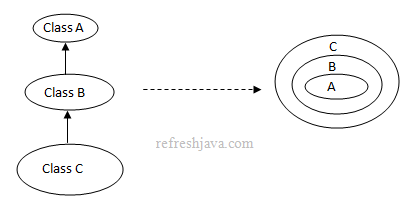Polymorphism is another fundamental principal of object-oriented programming. Sometimes beginners find it little difficult to understand what exactly the polymorphism is, so we will try to see this with some real world examples and programs to understand this easily. This tutorial covers different aspect of polymorphism like what is polymorphism, real world example, advantages of polymorphism etc.
What is Polymorphism in Java
The word polymorphism is made from two words, poly which means many and morphism which means forms or types,
so the word polymorphism means many forms. Polymorphims in java is a mechanism in which an object or it's behavior can have many different forms, we call such objects as polymorphic object.
Programmatically, in java the object of a child class can be assigned in any of its parent classes in the inheritance hierarchy which means the object of a subclass can take the form of any of it's parent classes in it's inheritance hierarchy, so we can say all the parent classes are basically different forms of child class, which is what the polymorphism is.
For example let's consider a scenario in which we have class A, B and C where class C extends class B which extends class A. In this case the object of class C can be assigned into class C, class B or class A which means the object of class C can take form of it's own, class B or class A.

C ob =newC(); B b = c;orB b =newC();// C class object will act as B class objectA a = c;orA a =newC();// C class object will act as A class object
As you can see object of class C can be assigned into any of it's parent class which means class C object can take forms of class B and class A as well along with it's own. This means object of C class is polymorphic in nature. The same happens with class B object as well which can take the form of it's own and class A.
Real time example of Polymorphism
To take a real time example, we can consider ourself. As a person we have many different forms like student, teacher, player, father/mother etc. The same person can be a teacher as well as a player, so we can say person object is polymorphic in nature.
Another real world example is your mobile. Sometime your mobile behaves as a phone, sometime as a camera, sometime as a radio etc. Here the same mobile phone has different forms, so we can say the mobile object is polymorphic in nature.
Polymorphism program in Java
classPerson { String name;voidwalk() { System.out.println("My name is "+ name+" and I can walk"); }voidtalk() { System.out.println("My name is "+ name+" and I can talk"); } }classTeacherextendsPerson { String subject;voidteach() { System.out.println("I teaches "+subject); }public static voidmain(String [] args) { Teacher teacher =newTeacher();// teacher object having it's own formteacher.name ="Rahul"; teacher.subject ="Math"; teacher.walk(); teacher.talk(); teacher.teach(); Person person = teacher;// teacher object takes the form of person objectperson.walk(); person.talk();//person.teach();// Can't call teach method as it's not in Person class} }
Output:
My name is Rahul and I can walk My name is Rahul and I can talk I teaches Math My name is Rahul and I can walk My name is Rahul and I can talk
Here the object of teacher class is polymorphic as it can take two forms, one as itself and other as person. Remember if an object of
subclass is behaving as parent class, then it can call the behaviors available in parent class only. In above example once the teacher is behaving as person, it can call only
walk and talk behavior.
How to check if an object is polymorphic.
Any object which have more than one Is-A relationship will be called as polymorphic object. For example in the scenario of class A, B, C given above,
following observation will be true.
C is-a C C is-a B C is-a A B is-a B B is-a A
So the object of class C and class B will be polymorphic as they passes more than one is-a relationship. But what about if we have the object of class A, will that be polymorphic ?. The answer is
yes, that will also be polymorphic. The reason is, every class in java internally extends Object class if it has not extended any other class, so in above case
class A will internally extend Object class, this way the object of class A will also be polymorphic.
So in java every object(except the object of Object class) is polymorphic, no matter whether it's an object of user defined class or java's predefined class.
An is-a relation in java can be tested using instanceof operator. If an object passes more than one instanceof test,
that object will be polymorphic.
C ob =newC(); if(obinstanceofC)// trueif(obinstanceofB)// trueif(obinstanceofA)// true
Advantages of Polymorphism in Java
- One advantage of polymorphism is that it allows us to reuse existing code which can make things easier to read and maintain. In program given above the object of teacher class can access it's own methods as well as the methods of person class.
- Another advantage is that, different form of objects can be referred with same type(parent class). For example if we have multiple child classes of Person class like student, employee, player etc, object of all such child classes can be referred with same type(Person class).
In java we have some more concepts/terminology in context of polymorphism which are runtime and compile time polymorphism. These polymorphism are categorized on the basis of resolving the call to a polymorphic method(A method having different forms). We will see these types in later tutorial.



